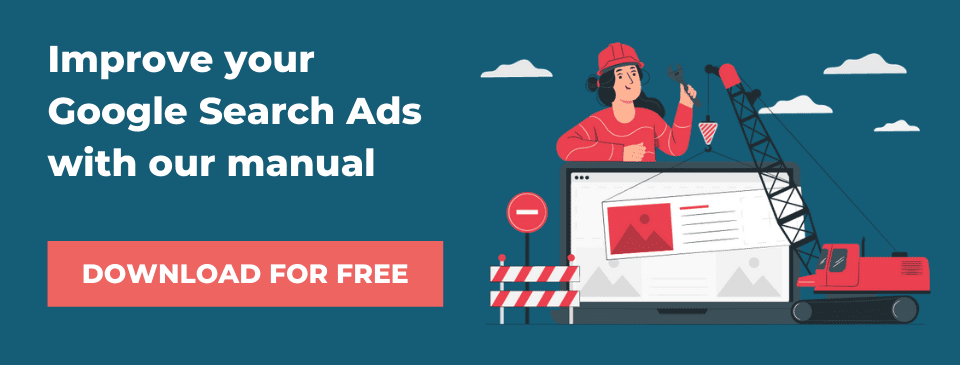The easy guide on how to improve low Ad Rank on Google Ads
“Here’s everything you need to know about Ad Rank, why it matters, and how you can improve a low Ad Rank on Google Ads in 5 simple steps.”
So let’s start from the very beginning – we all know the basics of Ad Rank, right? The specific position that your Ad has on Google’s paid search results. But do you know what factors come into play when breaking down Ads Rank?
If your answer is no, then you are in the right place! Ad Rank is very simple, however, most digital marketers struggle to improve it for their paid advertising campaigns. Let’s first take a look at what is Ad Rank and the factors that Google takes into account when ranking your ads before moving forward to the fun part.
- Ad Rank explained
- How is Ad Rank calculated?
- The Google Ads ranking factors
- Step-by-step guide on how to increase Ad Rank on Google Ads
- What next?
Ad Rank explained

We’ve all seen ads appearing in Google search results, which are offered via Google’s ads platform, but not many people know how Google determines the order in which ads appear on SERP. Oh, another essential factor – search engine results page! If you are not very familiar with this term, head over to our awesome article on what is SERP to stay in the loop.
A Google Ad rank refers to the position in which your ad sits on a given paid search results page. Let’s say your paid ad shows up second, which means that your Ad rank for the given search is number 2. In essence, any of your Google Ads Ad Rank represents a specific value that determines your ad’s position and if your ad will show up at all for a search on Google.
In early 2017, AdWords announced a few fundamental changes to the way that Ad Rank works. The main change has been the introduction of Ad Rank thresholds and machine learning. What does that mean? It means that your bid amount, the quality of your ads, and the Ad Rank threshold get passed into Google’s intelligent system. Once there, a specific keyword search gets analysed to determine what users are most likely looking for based on their previous behaviour. We know, pretty clever!
The result? According to experts, every search becomes different, which triggers different Ad Rank factors to carry more weight, but that’s not always the case. It is worth mentioning that Ad Rank is also known under the name of Ad Position, as these two terms are largely used interchangeably. Having a higher Ad Rank results in a better Ad Position, which, in turn, results in higher click-through rates (CTR), which will positively influence your Google Ad Rank Quality Score.
How is Ad Rank calculated?

Although there is no specific Google Ad Rank formula, many ranking factors must be considered and used accordingly. To put it simply, Ad Rank is calculated using:
- Your bid amount
- Your auction-time ad quality (including expected CTR, ad relevance, and landing page experience)
- The Ad Rank thresholds
- The competitiveness of an auction
- The context of people’s search (like location, device, search time, search terms, other ads, etc)
- The expected impact of extensions and other ad formats
All these factors will determine where your ads will appear and sit on the page and how much you will have to pay. We will talk about each element separately soon, but first, let’s understand what Google Ad Rank Quality Score means.
The popular view of the Ad Rank equation looks something like this:
Ad Rank = CPC BID x Quality Score
Here, the quality score is the 1 to 10 score shown in your Google Ads account, which is an aggregated estimate of your overall ad auctions performance. It is worth knowing that this score is seen as a historical grading of previous ad performance, the reason why it can be used at auction time to determine your Ad Rank. Even more interesting? Google has confirmed that high-quality ads lead to lower prices and better Ad Rankings too. To put it even simpler – raising your Ad Quality score will increase your Ad Rank.
The Google Ads ranking factors

Now, let’s look at each of the contributing Ads Rank factors in greater detail.
Your bid amount
This is the maximum CPC (cost-per-click) that you are willing to pay, which Google gives more weight if it’s higher. Most advertisers end up paying less than the maximum amount, however, you always need to be ready to pay this price. If you already have the highest Ad Rank, you will only pay enough to beat the second-ranked ad’s CPC. But keep in mind that in most cases, search terms are exceptionally competitive, so don’t go overboard in bidding if you can’t afford it.
Your expected CTR (click-through-rate)
Your ad CTR is the proportion of people that click on your ad through to a landing page. The expected CTR is a simple estimate of how likely people will click on your ads when shown to them. It’s worth noting that Google’s algorithm calculates this factor based on how well your chosen keywords have performed historically.
If you are wondering how to choose the best keywords for your paid search advertising campaigns, head over to our blog on how to do SEO keyword research like a pro.
Ad relevance
This is all about how much the keywords you’re bidding on match your ad messages. So try to ask yourself, “if people search for this keyword and my ad will show up, will it be relevant enough for them to click through?”.
This is where most marketers make a mistake! If the answer to that question is no, go ahead and rewrite your ad copy, maybe in a more compelling way. If you are not sure how to get started, you can check out our article on how to write persuasive copy for your landing pages to drive more sales for some inspiration.
Landing page experience
Google pays a lot of attention to your ad’s user experience! Why? Because in this way, Google can consider how well your ad’s link provides users with what they look for. And with this in mind, your landing page usefulness is calculated using a fascinating combination between automated analysis and human evaluation.
From the top of our heads, here are some quick and easy tips to improve your landing page experience:
- offer relevant, original and useful content
- be fully transparent
- foster trustworthiness
- make mobile and desktop navigation as easy as possible
- make sure your landing page loads fast
If you want to know more, you can check out our comprehensive guide on how to design the best eCommerce landing pages and get going!
Ad Rank threshold
This is where most people stumble upon. The threshold is the lowest Ad Rank score that your ads need to show on paid Google search results. And guess what happens if you don’t meet the threshold? Your ads won’t appear!
To avoid that from happening, make sure you pay closer attention to the following factors:
- ad quality
- ad position/rank
- user signals and attributes, like location and device
- topic and nature of search
- related auctions
Search context
Google loves crawling for long periods to understand people’s search intent in the best ways possible to determine how relevant your ads are to them. It’s pretty much like a game, where the players are:
- people’s exact search term
- their location
- devices used to search
- exact search time
In essence, it’s all about keeping Google’s algorithms happy for your ads to get displayed in front of your target audience(s).
The expected impact of ads format and extensions
And last but not least, it’s essential to know that Google Ads estimates how ads formats and extensions will impact your overall performance when calculating your Ad Rank.
The various formats and extensions available in Google Ads are:
- text
- images
- app promotion
- in-stream videos
- product/showcase shopping
- call-only ads
- phone numbers
- links to more specific pages on your site within your ads
Note that each of those factors serves different purposes, and Google will consider in detail how well they match your ads.
Step-by-step guide on how to increase Ad Rank on Google Ads

By now, you should already know the ins and outs of Google Ad Ranks, so let us show you 3 simple ways in which you can improve your Ad Ranks without spending more money than you need to.
Improve your Google Ad Rank Quality Score
If you haven’t noticed yet, there are two specific themes when discussing how to increase your Google Ad Rank. These are specificity and relevance.
The first step is to create specific Ad Groups, a critical component for any successful Ad Ranking. Most businesses run the risk of producing ads that are underperforming on expected CTRs, simply because their ad groups are not specific enough. Remember, searchers will always expect to find exactly what they searched for on Google, not less, not more, but their exact terms. Using hundreds of keywords and phrases in creating your ads will only confuse people and Google and generate CTRs that are way below your potential.
Generating bad CTRs and low relevance to your audience will significantly impact your quality score, forcing you to pay more for higher rankings than you need to. So try to opt for single keyword Ad Groups, as they have the most proven track record of increasing CTR by over 28%, as experts say. What single keyword ad groups means is that you take a single keyword and break it down into 3 match types – broad modifier, phrase, and exact. In this way, you will get all the benefits of specificity and broad searches, all whilst making sure that your top searched for terms receive specific ads, whilst including your targeted keywords at all times, without errors.
Even better? This ad group allows you to write ads with fully customised CTAs and value propositions for each keyword in particular, which means that every person will get much more specific offers, matching their exact Google search. We think that this is not only the easiest way to improve Ad Ranking, but it’s also the most cost-effective. So once you’ve created your single keyword Ad Groups, you can move onto developing much better landing pages.
Create better offers and landing pages
Have you ever clicked on a paid search ad but got something completely different from what you were expecting? Yes, we’ve all been there, and it is beyond frustrating, especially when you are short on time and looking for a birthday gift for your partner two days before the date! This is when the ad says one thing, but the landing page says something completely different. Even worst? Sometimes, it’s a simple home page!
Your landing pages must have a precise message match, which will, in turn, improve your conversions by more than 200%. Now that’s a game-changer! But we know why marketers don’t put their best effort into creating eye-catching and relevant landing pages – they are time-consuming, and we know time is money. So what you need to do is to standardise your landing page copy for each paid campaign, and when the time comes, change bits of copy so you can customise all your offers. We’ve done this for our clients’ hundreds of times, and we’ve seen huge increases in their ad performance and in the amount of time saved both for them and for us.
What you essentially need to do is to go to the back end of your landing page and edit key characteristics to match your exact ad group and offer. If you want to have a high Ad Rank and Quality Score without making big investments, your landing page user experience must be top-notch! For some great advice and tricks, head over to our article on 5 best practices for eCommerce landing pages and how to design a landing page that converts. If you genuinely put in the work, your results will show up!
Improve your keyword strategy
We know we talked about this before, but we can’t stress enough how important keywords are to increase your Google Ads ROI with the least amount of effort.
Start by looking at the search terms for your keywords so that Google can reward you with a higher Quality Score and average positioning compared to those of your regular keywords. Using the SemRush Keyword Magic Tool, you will find different variations of your chosen keywords, which will significantly help increase your Ad Rank. Why? You might end up finding new keyword options with higher Quality Score than the ones you are using currently.
Also, don’t forget to include your main keywords within your meta tags to increase relevancy between keywords and landing pages. In case you didn’t know, meta tags are bits of text at the source code level, mainly used to describe a landing page’s content. Browsers will reference this text to identify what kind of information is available on your pages, and these short snippets of content are as valuable to your page as they are to search engines like Google because they help to connect people to their desired topics. But keep in mind that meta tags work like tags, but the only difference is that you won’t see meta tags on the page, as they exist at the HTML level, usually at the “head” of the page, is visible only to Google and people who know where to look! So pay close attention, and include your keywords in all your meta tags, which are:
- Meta title
- Meta description
Accelerator
Use your targeted keywords at the beginning of your meta title, so if SERP shortens titles of a certain length, the most relevant part of your title will still be displayed.
What next?

And now you may wonder, what next, now that you know how to improve your Google Ad Rank. Now it’s time to note all the factors discussed above, and put them in practice whilst implementing a strategy to address all those areas for every single paid advertising campaign you wish to create in the future.
However, understanding the fundamentals of paid search advertising is critical for running paid campaigns that perform well, so put yourself up to date by reading our article on your beginners guide to PPC. If you’re interested in learning more on this topic, why not download your FREE Google Search Ads Manual so you can start improving your online performance in 8 simple steps right now!
We know that Google Ads can feel like a challenging part of marketing to understand at times, the reason why at Lnet Digital, we offer comprehensive paid advertising services, covering Google Ads PPC, Social Media PPC, increasing ROI, and optimising ad spend, just to name a few so that our clients can receive better results. So what are you waiting for? Get in touch with our friendly team of experienced digital marketers, and let’s start finding together with the solutions that fit your business and your audiences the best!






